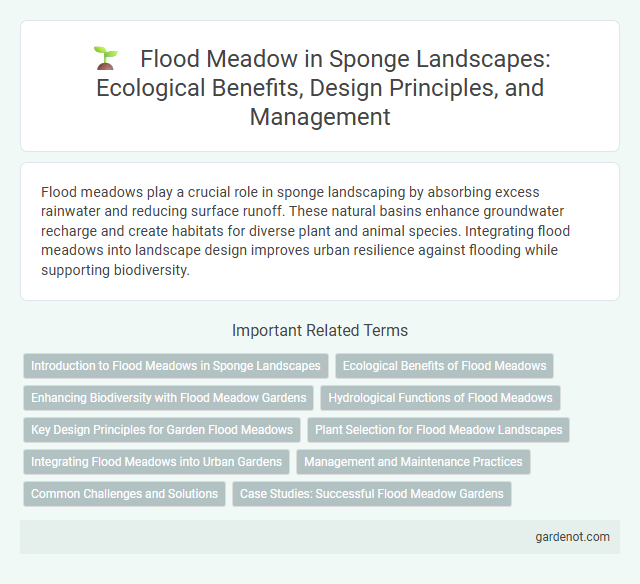Flood meadows play a crucial role in sponge landscaping by absorbing excess rainwater and reducing surface runoff. These natural basins enhance groundwater recharge and create habitats for diverse plant and animal species. Integrating flood meadows into landscape design improves urban resilience against flooding while supporting biodiversity.
Introduction to Flood Meadows in Sponge Landscapes
Flood meadows in sponge landscapes serve as natural water retention areas, absorbing excess runoff and reducing flood risks. These meadows support diverse plant species adapted to periodic inundation, enhancing biodiversity and soil health. By slowing water flow and promoting groundwater recharge, flood meadows contribute significantly to sustainable flood management and ecosystem resilience.
Ecological Benefits of Flood Meadows
Flood meadows enhance biodiversity by providing diverse habitats for amphibians, birds, and pollinators, supporting ecosystem resilience. They act as natural flood buffers, absorbing excess water and reducing downstream flood risks, improving water quality by filtering pollutants and sediments. Their periodic inundation fosters nutrient-rich soils that sustain native plant communities and promote carbon sequestration.
Enhancing Biodiversity with Flood Meadow Gardens
Flood meadow gardens significantly enhance biodiversity by creating dynamic wetland habitats that support diverse flora and fauna. These gardens serve as natural water absorbers, reducing runoff and providing breeding grounds for amphibians, birds, and pollinators. Integrating native plant species in flood meadows promotes ecosystem resilience and fosters a balanced, thriving environment.
Hydrological Functions of Flood Meadows
Flood meadows serve as natural sponges by absorbing and temporarily storing excess floodwater, reducing peak flow and mitigating downstream flooding. Their rich vegetation and soil composition enhance groundwater recharge and improve water quality through sediment filtration and nutrient uptake. These hydrological functions support biodiversity and maintain ecosystem resilience in flood-prone landscapes.
Key Design Principles for Garden Flood Meadows
Flood meadows thrive by integrating natural water retention with native plant species, optimizing seasonal flooding and soil absorption. Key design principles emphasize graded terrain for controlled water flow, selection of moisture-tolerant flora like sedges and rushes, and maintaining biodiversity to support local ecosystems. Proper layering of soil and vegetation enhances infiltration, reduces runoff, and promotes groundwater recharge within garden flood meadows.
Plant Selection for Flood Meadow Landscapes
Selecting native flood-tolerant plants such as sedges (Carex spp.), blue flag iris (Iris versicolor), and switchgrass (Panicum virgatum) enhances water retention and soil stabilization in flood meadows. Incorporating deep-rooted species like willows (Salix spp.) and buttonbush (Cephalanthus occidentalis) promotes resilience against seasonal flooding and supports biodiversity. These plant choices optimize floodwater absorption, reduce erosion, and provide critical habitat for wetland wildlife.
Integrating Flood Meadows into Urban Gardens
Integrating flood meadows into urban gardens enhances water management by naturally absorbing and filtering stormwater, reducing runoff and mitigating urban flooding. These landscapes support biodiversity by creating habitats for native plants and wildlife, contributing to ecological balance within city environments. Incorporating flood meadows also improves soil health and promotes sustainable gardening practices through organic matter accumulation and nutrient cycling.
Management and Maintenance Practices
Flood meadows within sponge landscapes require precise management practices to sustain their natural floodwater retention capacity and biodiversity. Maintaining seasonal mowing schedules, controlling invasive species, and managing water levels through monitored sluices or channels optimizes soil saturation and prevents nutrient depletion. Regular inspections and adaptive interventions enhance the ecological resilience and functional performance of flood meadows as natural flood mitigation systems.
Common Challenges and Solutions
Flood meadows often face challenges such as waterlogging, nutrient runoff, and invasive species growth that disrupt native vegetation. Implementing controlled water flow systems and planting native, flood-tolerant species enhance soil absorption and biodiversity. Regular monitoring and adaptive management mitigate these issues, promoting effective sponge landscape function.
Case Studies: Successful Flood Meadow Gardens
Flood meadows have been successfully integrated into urban and rural landscapes as natural sponge gardens that manage stormwater while enhancing biodiversity. Notable case studies, such as the Exeter Flood Meadow in the UK, demonstrate how native plant species absorb excess water, reduce runoff, and provide habitat for pollinators and aquatic wildlife. These projects combine ecological engineering with aesthetic design to create resilient green spaces that mitigate flooding and improve water quality.
Flood meadow Infographic

 gardenot.com
gardenot.com